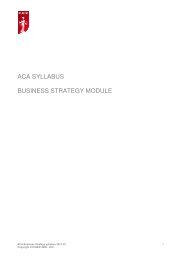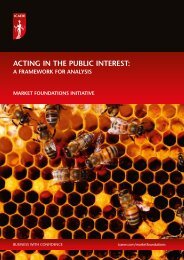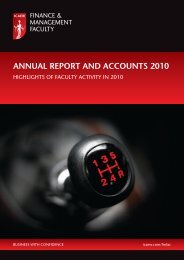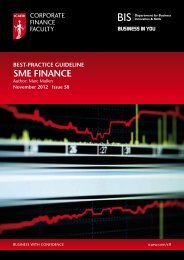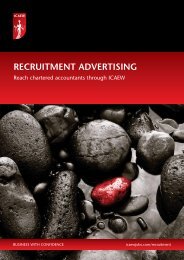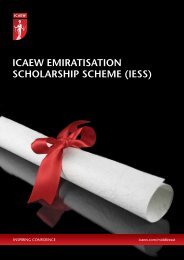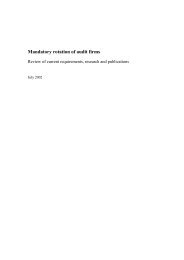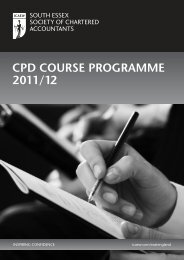Auditor independence and non-audit services - ICAEW
Auditor independence and non-audit services - ICAEW
Auditor independence and non-audit services - ICAEW
You also want an ePaper? Increase the reach of your titles
YUMPU automatically turns print PDFs into web optimized ePapers that Google loves.
Provision of some of these <strong>services</strong> could provide a real or perceived threat to<strong>independence</strong> in the case of an <strong>audit</strong> client. The principal threats which arise from theprovision of NAS are:• self interest: the increase in economic dependence;• self review: taking management decisions <strong>and</strong> <strong>audit</strong>ing one’s own work;• advocacy: acting for the client’s management in adversarial circumstances;<strong>and</strong>• familiarity: becoming too close to the client’s management through the rangeof <strong>services</strong> offered.Intimidation is the only one of the five threats which does not obviously arise from theprovision of NAS. NAS is therefore a wide ranging threat to <strong>independence</strong>. Table 3.2shows how the regulatory frameworks we have reviewed address these threats <strong>and</strong>recommend how they should be managed. (We have not included Ontario in this tableas there is insufficient detail to make meaningful comparison with the others.) In thetable we have classified the guidance (or rules) on the various activities into fivecategories:• no: an absolute prohibition;• normally no: prohibited except in very limited or exceptional circumstances;• no if material: permitted if the figures involved are not material to thefinancial statements;• caution: requires the threats <strong>and</strong> safeguards for each case to be consideredbefore proceeding;• yes: permitted without restrictions; <strong>and</strong>• no specific guidance: where the service is not specifically referred to in therules or guidance.None of the frameworks offers guidance on all the types of <strong>services</strong> identifiedthroughout. It is also possible that there are <strong>services</strong> being provided or developed bythe firms which are not picked up by any framework where guidance may be needed.In all frameworks except SEC, which is rule based, the absence of reference to aspecific activity (i.e. our classification of no specific guidance) is of limitedsignificance because, in theory, all activities should be swept up by the over-ridingprinciples. The position with SEC is less certain as the principles set out in SEC arenot actually part of the rules.IFAC is the most comprehensive. Australia is almost identical to IFAC <strong>and</strong> wasadopted after the comprehensive review of <strong>independence</strong> in the Ramsay Report(2001). <strong>ICAEW</strong> was developed in 1997, <strong>and</strong> being rather older, is less explicit in anumber of areas than the more recently developed frameworks. <strong>ICAEW</strong> explicitlyrecognises the possibility of advocacy being a threat in respect of taxation <strong>services</strong>.SEC has more restrictions <strong>and</strong> shows the least flexibility. There are no instances inSEC of caution i.e. where professional judgment about the balance of threats <strong>and</strong>safeguards is recommended. SEC reflects the more rule-based environment whichexists in the US. There are some interesting differences between the frameworks. SECimposes more restrictions on internal <strong>audit</strong>. EC <strong>and</strong> SEC impose more restrictions oninstallation of financial information technology systems, whereas the others permitproceeding with caution.20




